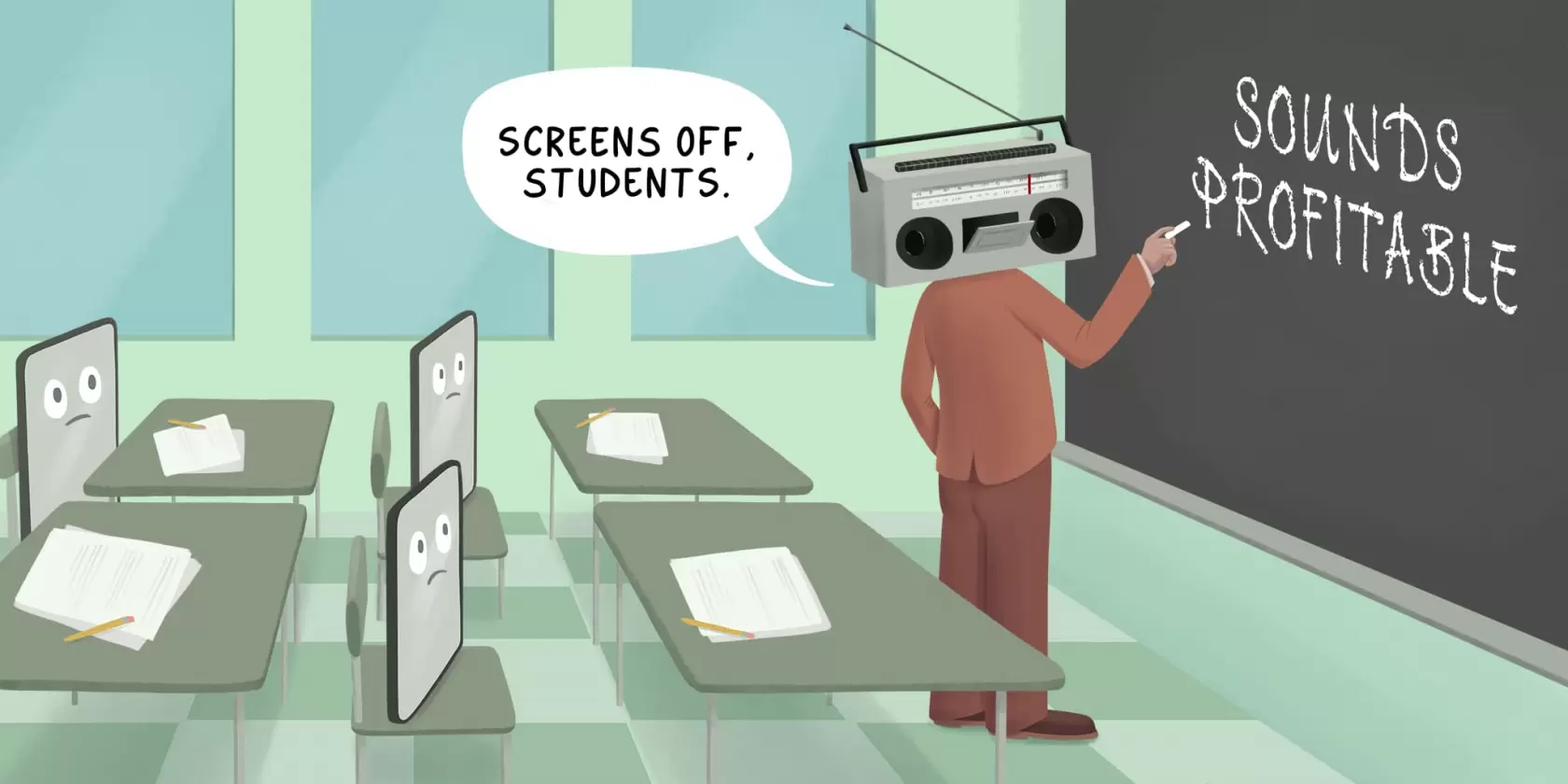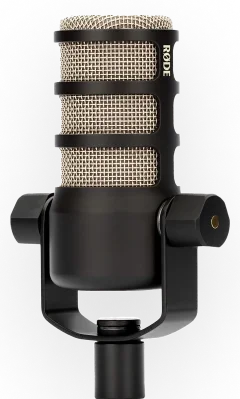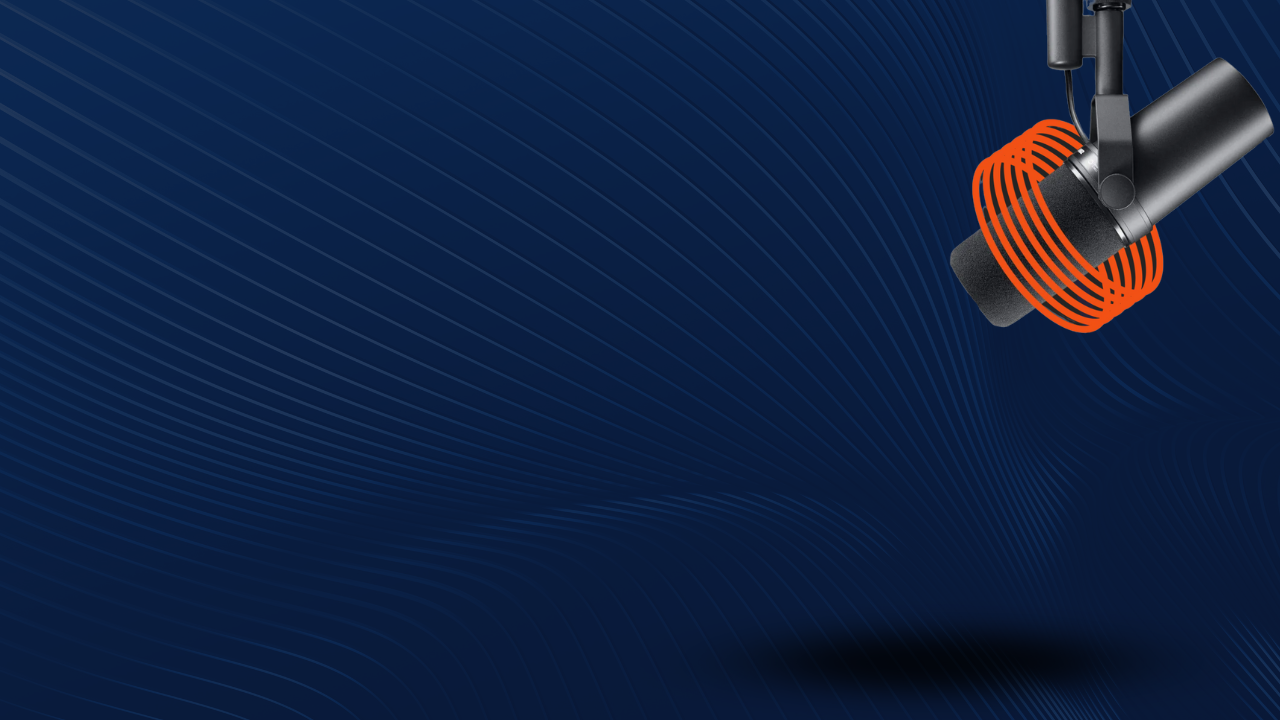So I sat down to write this article a while back, and when I picked my head up I had over 4,700 words. That would indeed make for a very scary, Halloween edition of Sounds Profitable, so I decided to give you all a break and split this into two parts. I hope you enjoy Part One!
Podcasting has had a bad couple of months in the press, from Podcast Movement’s Ben Shapiro kerfuffle, to layoffs at Spotify and Acast, iHeart’s dalliance with “Subway Surfer,” Vulture claiming podcasting doesn’t produce blockbuster hits any more, and on and on. Truly a rich pageant. It’s worth remembering a few things about all of this. First, there is a wealth of information out there that tells the positive story of podcasting, from the Super Listeners research series I once worked on, to our own studies here at Sounds Profitable, like After These Messages, and We’ll be Right Back. Yes, podcasting is just as susceptible to criticism as any other medium, and the fact that we are currently weathering some of that just means that podcasting is starting to punch at its weight class, after years of toiling away as an “experimental spend” for advertisers.
It’s also worth telling yourselves, in those low moments, that the seeming torrent of criticism podcasting has been enduring lately is coming through other media channels, themselves facing even worse economic pressure than podcasting is. I mean, let’s really compare how much of the professional podcasting space is cutting headcount compared to digital, or radio. So, turn that frown upside down, podcasters.
The reason I continue to be bullish about podcasting is that I have seen this movie before. Podcasting is not that much different to any other audience-driven media, and luckily for us we have plenty of examples from the past from which to learn so that we can not only survive, but thrive during this seeming economic downturn.
One of the biggest reasons I got into podcasting was, perversely, my love of radio. To me, podcasting was not a medium of the future, but one firmly rooted in the past. It was what radio used to be, and lost along the way. When I pushed Edison to include podcasting on the Infinite Dial back in 2006, I wasn’t interested in RSS, or in any particular podcast over another (though I had some favorites.) I did it because I believed that the behavior podcasting enabled (the ability to listen to truly interesting spoken word content wherever and whenever you wanted) was truly universal, and I wanted to chronicle that from the beginning.
Today, podcasting is a vibrant and interesting space, regardless of what Vulture writes about it. But radio? Commercial radio is steadily declining. That’s not me telling you this. That’s Nielsen telling you this. Lost in the incessant march of monthly and quarterly share ratings from Nielsen is the hard truth that time spent listening to radio has dropped precipitously over the last 10 or so years. Indeed, Edison’s Share of Ear data shows that radio’s share of our audio time has declined from 52% in 2014 to about 38% today, with streaming music and podcasting surging to claim the time radio has ceded. With total time spent listening to audio remaining fairly constant over that period of time, that’s a 27% decline in 8 years. You’d feel that in your household budget.
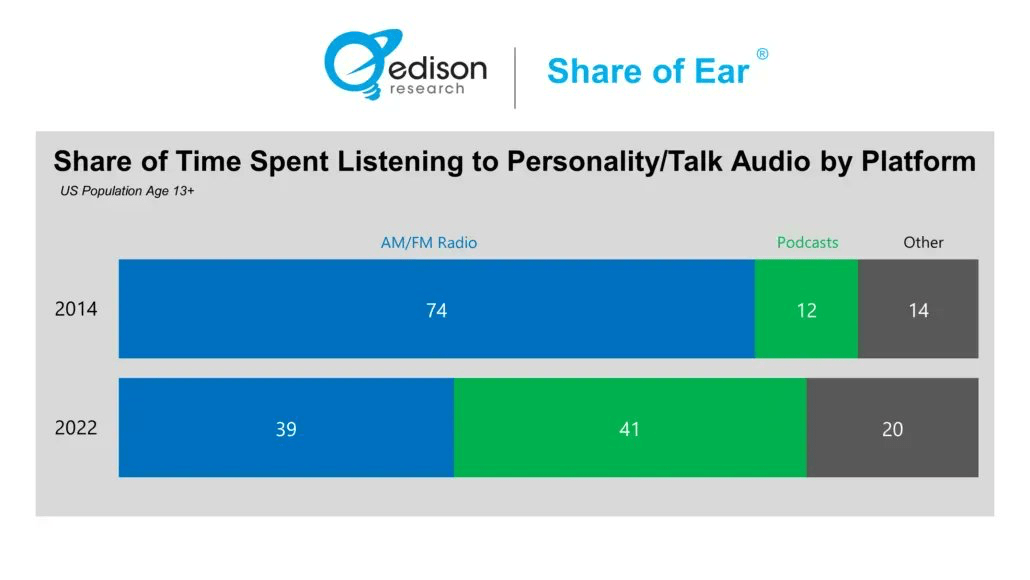
Edison also just put out a stat that showed podcasting has surpassed AM/FM radio in overall share of personality/talk audio. Now, to be honest, I wouldn’t get too wrapped up in the 2022 snapshot numbers here, which are a little messy. After all, among the Top 50 podcasts are such on-demand stalwarts as This American Life, Fresh Air, Ben Shapiro, Dan Bongino, Dave Ramsey, and The Breakfast Club. The sharp-eyed will have detected what they all have in common (they are all AM/FM content) which means the survey is reliant on the respondent to decide if they were listening to “the radio” or to a podcast. Still, it’s the trend that cannot be ignored here. Spoken word is moving away from the radio, and towards the mobile phone–and podcasting, as I wrote about a month ago.
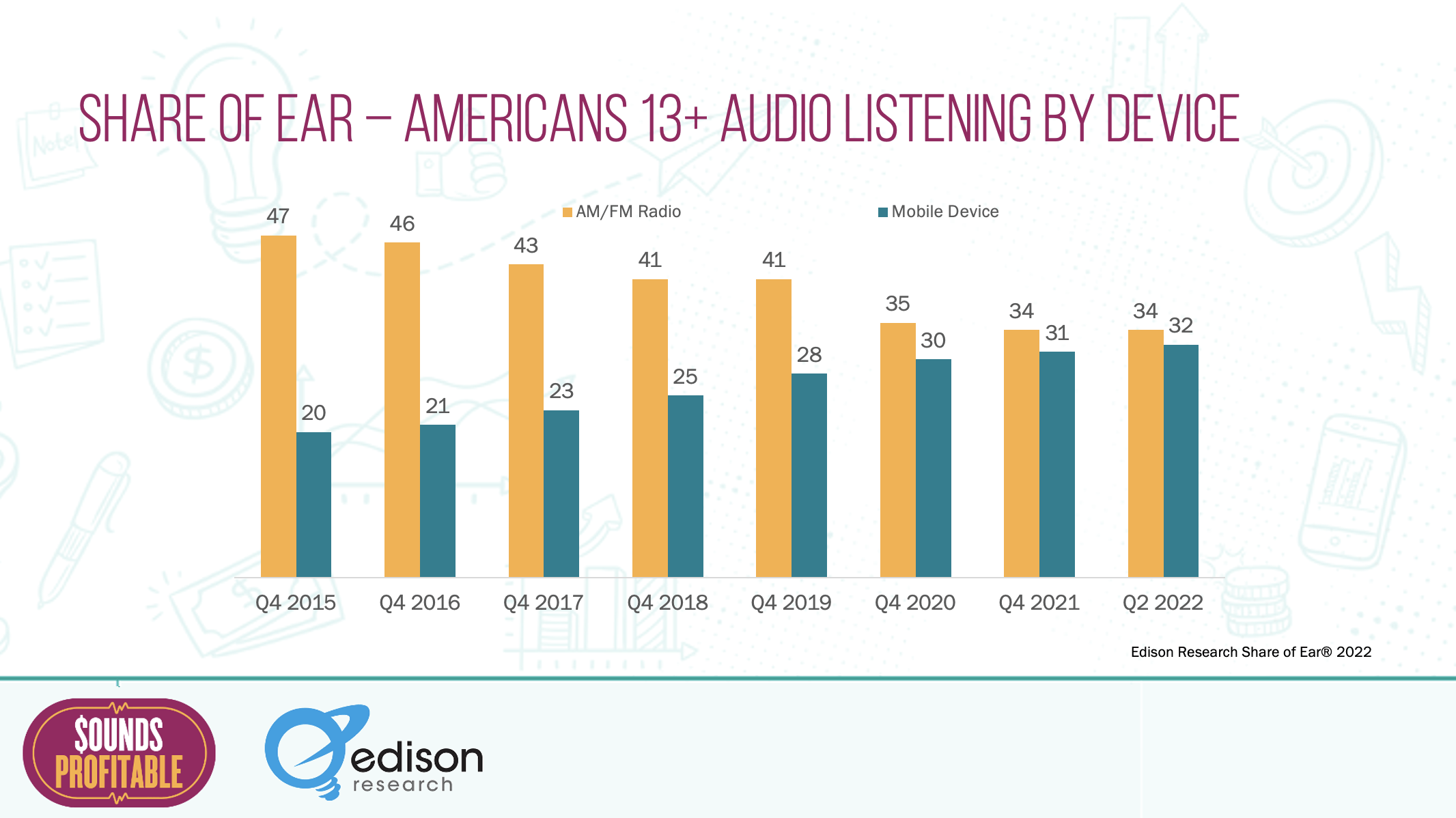
I think the podcasting industry has a lot to learn from radio, but it isn’t what many in the radio industry think. I hear a lot of long-time broadcasters talking about what they have to teach podcasters, but as my former grad school English Dept. intramural basketball teammate, the poet Bruce Wiegl, once wrote, sometimes what we pass on is not a gift. Radio has given us many wonderful positive examples that translate (and have translated) well to podcasting.
But Radio is not just an example for podcasting. It’s also in some cases a horrible warning. The past couple of months has seen some critical press for podcasting, from buying downloads through mobile gaming ads, to insinuations that the industry can’t build anymore “blockbusters,” and even layoffs. Much of this press, I disregard. I’d rather be in podcasting than in ad-supported web content right now, that’s for sure, at least until we come up with the “audio fly-over” and the audio equivalent of the “Accept Cookies?” overlay. Yet, some of the criticism is also enormously valuable, because it does hint at some choices this industry is making, and could make in the future, that represent forks in the road.
I am no Nostradamus, but I have lived through the radio industry making some of those same choices, and I have seen how they have worked out. Spoiler alert: not well, at least for commercial broadcast radio. I want to share with you some of those horrible warnings, and thoughts on how to avoid them. We are clearly headed towards some kind of economic “correction,” let’s say, and there is no reason why a clear-headed podcasting industry won’t weather this better than any other medium. So let’s go.
1. Painting With The Same Brush
Beginning with my absolute favorite let-me-bore-you-for-hours-at-the-cocktail-reception topic, the Telecommunications Act of 1996, elements of the commercial radio industry have been biting off more than they can chew for a quarter of a century. The largest radio companies in America became the largest through a feverish period of acquisitions, which certainly gave them leverage in every sense of the word. The resultant debt that this literal handful of companies had to service became untenable, and led to a few Chapter 11 restructurings. iHeart recently was able to restructure over 16 billion in debt to just under 6 billion in debt a few years ago, but there is still 6 billion in debt, which if you laid every dollar end to end it would stretch to the moon. I think. My math might be shaky.
The constraints that this amount of debt placed on the largest operators in radio led to years of layoffs, budget cuts, and otherwise just bad news. But here’s the thing: while the largest operators were burdened by crushing debt service, there were plenty of smaller groups and locally-owned stations that were doing just fine. Radio continues to throw off huge amounts of cash flow–it may be down, but it didn’t crater like the classifieds business did. People still listen to the radio. Lots of people still love radio. But the very public struggles of a few operators painted the whole industry with the same brush, a fact that I know was very frustrating to any number of operators all across the country.
We need to be vigilant about this in the podcasting industry. The signs are all around us. Ashley Carman’s recent Bloomberg piece, “Podcasters Are Buying Millions of Listeners Through Mobile Game Ads”, is an enormously helpful piece of journalism for our industry. We need to be ever vigilant to things like this, because we don’t have the same margin for error that web, radio, and TV currently enjoy (I mean, what percentage of web clicks do people simply just write off at this point?) If there was one thing that I wish were different about that article, though: the word “podcasters” in the headline. It wasn’t podcasters that were buying millions of listeners–it was iHeart that was buying millions of listeners (there were two significantly smaller players named in the piece, but their footprint was certainly not in the “millions of listeners.”)
In circumstances like this, sure–we can call out the “unhelpful actors” in the space–but even better is to continue to raise our standards for measurement and transparency, so that literally gaming the system isn’t possible. The “system” in this case is Podtrac, and it isn’t the first time iHeart has been observed engaging in activity that juices their rankings there. So, at least part of the issue with gaming Podtrac, it seems to me, is that Podtrac is gameable. I have already written at length about some of the issues with prefix analytics in podcasting. iHeart traffics on this ranking to proclaim itself the #1 network in podcasting. It is clearly not (it’s well behind SXM and Spotify, bunched in the second tier as far as networks go). So one of the levers that we can pull to avoid as an industry being painted with the same brush is to also hold the system accountable, with more stringent standards, and more transparency. As Din Djarin would tell us, “This is the way.”
When we see things like this, as an industry we need to call them out and sharply correct the record. I think the same is true when pundits attempt to conflate one company’s unfortunate round of layoffs with some kind of structural weakness in the entire industry. The brave persons doing sterling service for Spotify’s podcasting division are surely not the reason why Spotify has not been profitable since its inception in 2006. When there are systemic problems in podcasting, you can expect Sounds Profitable to be at the forefront of trying to solve them. But you can also expect us to be a voice against painting us all with the same brush when it isn’t warranted, because I have seen first-hand what that can do to an entire industry.
2. Please Don’t Destroy Us With Ads
I don’t need to say a lot about this one, I hope. One of the primary reasons AM/FM content has been unsuccessful online is that the online streams of broadcast radio stations carry the same crippling, nonsensical spotloads as their over-the-air counterparts. These simulcast streams aren’t competing with other radio stations; they are competing with programming that is either ad-free (Spotify Premium) or ad-spartan (Pandora’s free service). Last weekend I gave one of the ad-supported Sonos stations a try, and I was horrified to hear two eight-unit blocks of ads, just twenty minutes apart. That’s just not going to fly in 2022. It hasn’t flown in a long time.
Spotloads are hands down one of the biggest problems in commercial broadcast radio. The current ratings methodology for radio awards a station an entire quarter hour of listening if a respondent listens for five minutes of that quarter hour. That means, as I have written before, that you could listen to Hotel California and then check out for 10 minutes of ads, but the ratings will report you as having listened for the entire time. Truly, you can check out (most) any time you want, but you can never leave.
This low resolution methodology means that radio hasn’t had to right its ship in terms of spotloads. If ratings were reported second to second, if the actual audience for a commercial were reported by Nielsen, radio stations would find religion on this issue right quick. But it isn’t, and they haven’t.
In podcasting, though, we do have that kind of granularity. Which means we aren’t going to get away with long spot blocks, and we aren’t going to get away with crappy ads, and we aren’t going to get away with running the same DAI ad three or four times in an episode as some of the shows Bryan wrote about a few weeks ago. I am not necessarily one of those that thinks of podcasting as some kind of pristine, special snowflake that must not be sullied with something so crass as an announcer-read ad. In fact, we have taken great pains in some recent research to show that there are multiple paths to the creative execution of successful podcast ads. But we are not measured like radio, and we cannot act like radio. Podcasting’s metrics are WAY better than those of the radio industry, and our listeners have millions of other choices available to them just a phone’s length away.
3. Don’t Neglect The Farm Team
One of the unpleasant byproducts of the financial distress some of the largest radio groups have grappled with over the last decade has been the disappearance of local DJs. It started with overnight jocks being replaced by automation, then the voice-tracking of other shifts by personalities in other markets handling those duties for multiple stations, and finally, in many markets, the local morning shows being replaced by one of a handful of syndicated shows from larger markets.
This, as it turned out, was a doubly-devastating move by the radio giants. In the present moment, it made those stations a lot less personable, engaging, and local. But it also cut the entire industry at the hamstrings because it eliminated radio’s pathways for future talent. Pre-consolidation, the lively overnight jock had the opportunity to get better, and eventually get a mid-day shift before maybe being noticed by another station in another market. They had the ability to work at their craft, and get better, ensuring radio always had a pipeline for talent. It was this system that allowed a jock at WIXZ in McKeesport, Pennsylvania, who called himself “Bachelor Jeff” move from middays to morning drive, before moving on to stations in Pittsburgh, Kansas City, and Sacramento before finally being recruited by ABC Radio Network to have his own nationally syndicated show. This is how Rush Limbaugh became Rush Limbaugh. Love his politics or hate them, Rush became an outstanding broadcaster because he had a path to get better, and get discovered.
With the elimination of all of the kinds of local positions Limbaugh was able to hop around in, there is no farm team for radio, and no path to discover new talent. Instead, radio has necessarily become incredibly risk-averse: when you need one talent to fill the morning show on 50 markets, you aren’t going to take many chances.
Talent development is something I know the biggest networks think about, but many of them think about it in terms of acquisitions. But we also need to find ways to cultivate podcasting’s farm team–the talent that isn’t quite there for a million-download show yet, but you can see it happening with the right tutelage. I think it’s important for any publisher to think about developing not just new shows, but new podcasters. It’s expensive to buy the Joe Rogans. It’s rewarding to find the next Bachelor Jeffs. Want a head start? All of those people recently let go by Spotify and Acast and Warner shouldn’t remain unemployed for a single day.
Wrapping Up
Three down, and four to go. I trust you have been delivered to the end of this article in reasonably good condition, as I have spared you my initial 4,700 word outburst, and that you’ll join us next week for the rest! Part Two of this article will dive more into content, changing demographics, and something radio used to do very well that could make all the difference for podcasting.
Market Insights with Magellan AI
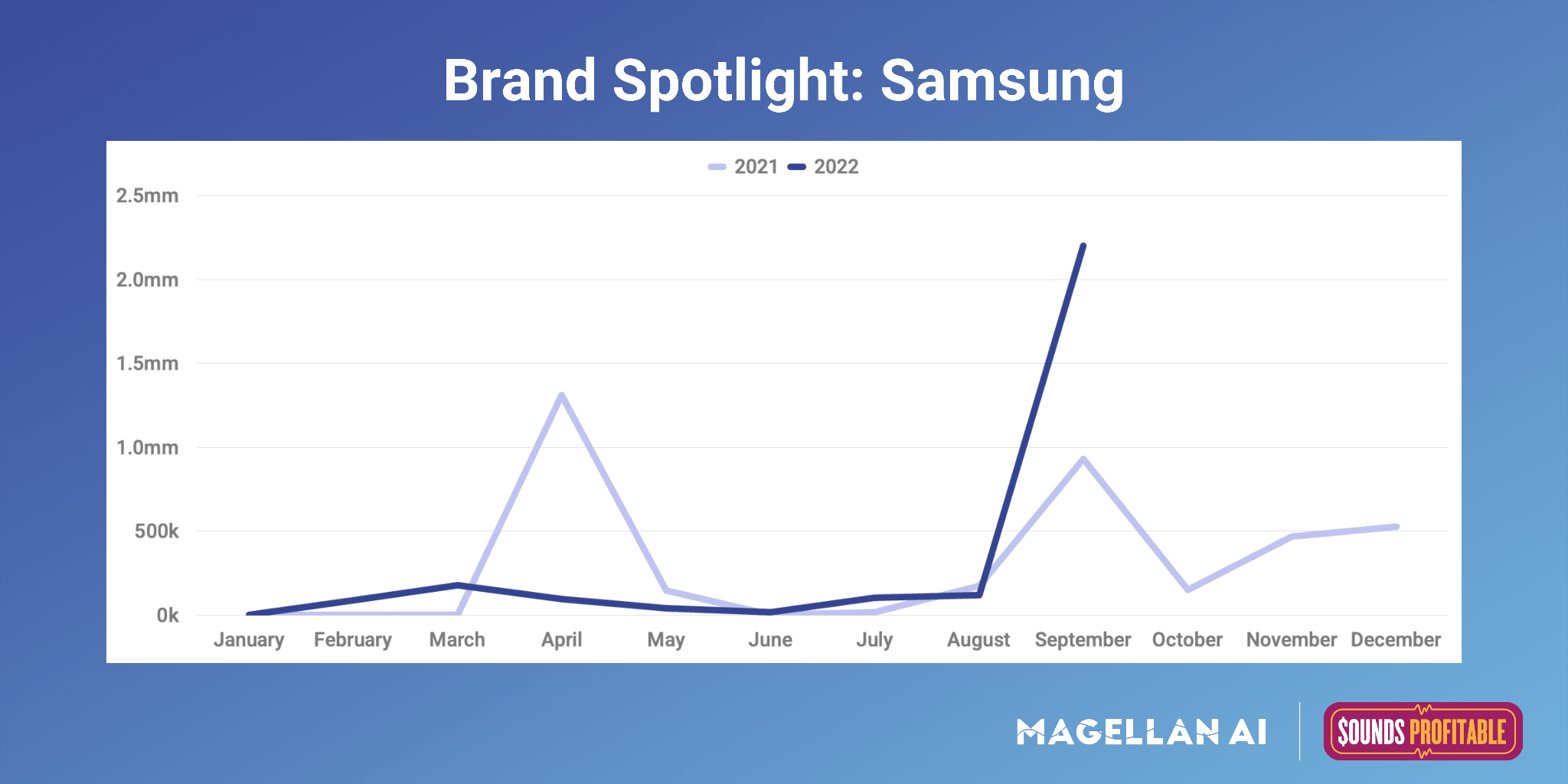
This week we are highlighting the Samsung which increased its spend by over 1500% between August and September. In September Samsung spent over $2mm promoting its newly released Samsung Galaxy Z Fold4, the most it has spent in a single month to date.
In its September campaign Samsung primarily advertised on Sports and Football shows, along with Comedy. The last time Samsung ran a major campaign was for Mother’s Day in 2021 when it spent $1.3mm. For that campaign Samsung primarily targeted Society & Culture, Sports, and TV & Film shows.
Interested in more insights like this? Sign up to join the 15-minute monthly market update
Anatomy of an Ad with ThoughtLeaders

Sponsoring brand: Manscaped
Where we caught the ad: uNcomfortable
Who else has sponsored this podcast?
Where else has this brand appeared? Hey Fam…! With Andrew Levins and Angus Truskett, The Smoking Tire, WrestleTalk Podcast, The Steve Dangle Podcast
Why it works: The Manscaped ad-read takes place in the middle of the episode, right in the middle of a story – so listeners are thoroughly engaged and attentive (ideal time to feature a brand sponsorship). Also, this podcast focuses on topics that reside on the fringes of our reality and brings them front and center, which is exactly what Manscaped is trying to do – bring the uncomfortable topic of below-the-belt grooming into the spotlight.
New Partners
Sounds Profitable exists thanks to the continued support of our amazing partners. Monthly consulting, free tickets to our quarterly events, partner-only webinars, and access to our 500+ person slack channel are all benefits of partnering Sounds Profitable.
- After having empowered billions of people to sing-along on major music services with time-sync’d lyrics, the Musixmatch Community is now on a mission to transcribe podcasts to make them more them accessible, discoverable and sharable.
- REALM is the world’s largest fiction podcast network known for chart-topping, immersive shows that reach valuable audiences; their growth and sales teams bring an analytics-based performance marketing approach to their ad partners.
Want to learn more about partnership? Hit reply or send us an email!

